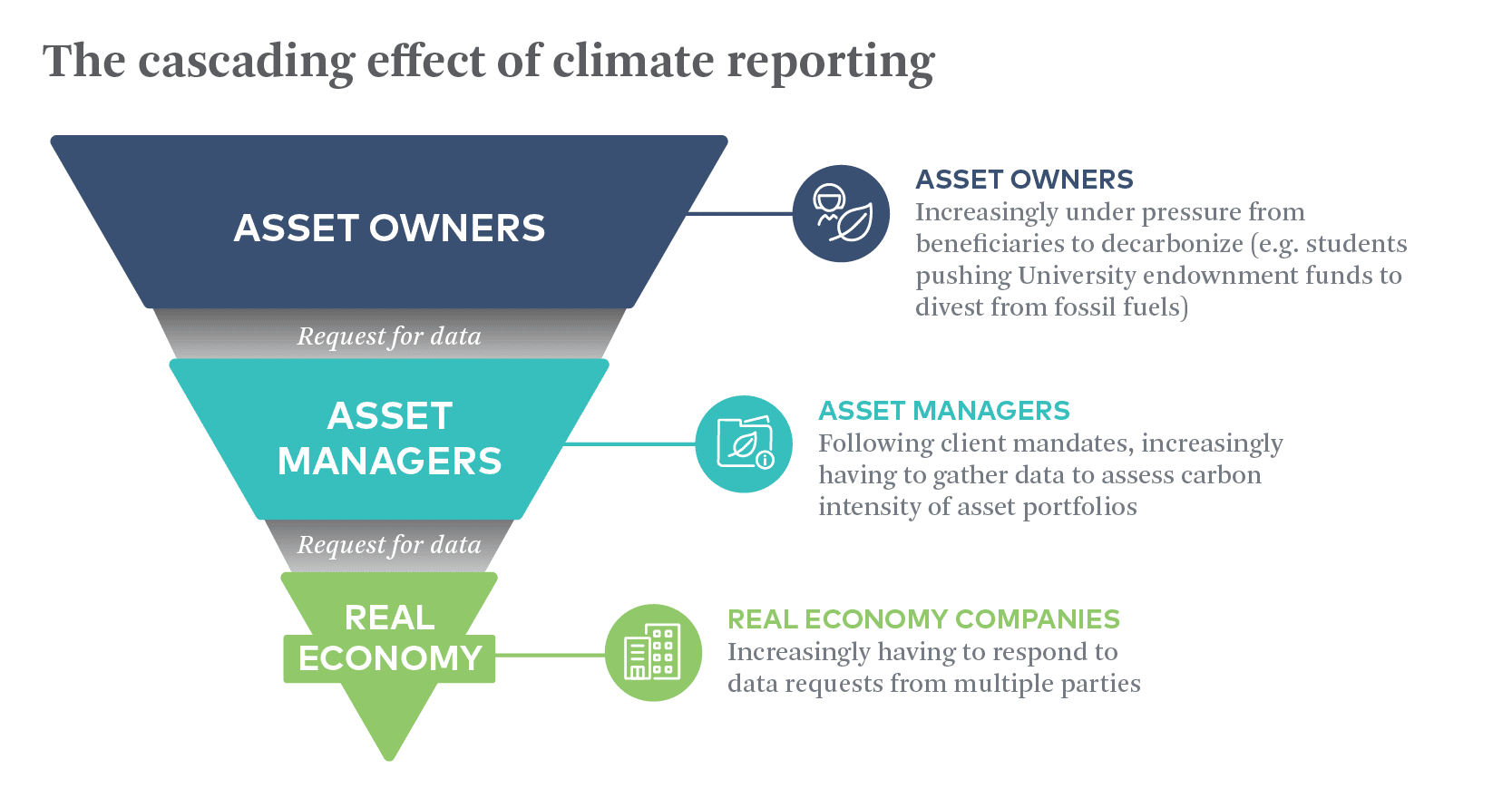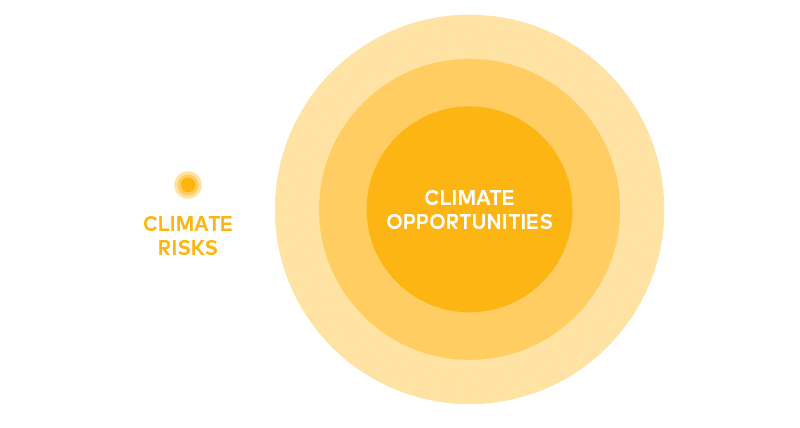It is valuable for every company to have familiarity with the framework set out by the Task Force on Climate-Related Financial Disclosures (TCFD), and with climate-related risks and opportunities more generally. In this article, we’ll explain why.
The cascading effect of climate reporting
Over the past few years, we have been witnessing voluntary sustainability reporting frameworks becoming increasingly mandatory in markets where regulation did not previously exist. Governments and regulators all over the world have been responding to investor-led demands for climate risks to be disclosed and quantified, with TCFD rapidly becoming the disclosure framework of choice in the EU, US, and UK (to name just a few jurisdictions), along with global standard-setters such as the International Financial Reporting Standards (IFRS) Foundation.
For a company monitoring these developments, the intuition is to start by asking a simple question – are we in the scope of these rules? And while that is a logical question to ask, we should begin with investigating the drivers. Regulators such as the U.S. Securities and Exchange Commission (SEC) and the EU Commission1 are mainly responding to the wider demands of investors.
At 3Degrees, we’ve been calling this view of starting at the top, “the cascading effect of reporting,” which is currently underway and at this point, irreversible.

Every time another bank or financial institution makes a decision to report its climate risks and opportunities in response to regulatory changes, the next step is to start scanning the asset portfolio for its climate risks and opportunities, as well as existing mitigation actions or opportunities. Investors are also asking for the total financial impact, which is leading to more concerted integrated reporting with more than 2,500 companies across the globe having issued integrated reports to date2.
A lot of companies are still understandably weary of disclosing the potential price tag associated with their climate risks in their main financial statements. However, it’s clear that the risks of climate change come at a significant cost, with some companies’ CDP reports revealing eye-watering estimates. One insurer has estimated that losses from nature-related catastrophes could increase its annual exposure by almost $3BN, and that the cost of response (reinsurance) was likely to be in the order of $0.5BN.
Climate risk is a risk like any other
|
What is Enterprise Risk Management (ERM)? ERM involves assessment of risks facing the organization, classifying them by their impact and probability, and determining which actions to take to mitigate, transfer, avoid or accept them. |
With such potentially high costs on the line, every company, whether impacted by the recent and upcoming regulation or not, should develop the internal capability to understand and assess climate-related risks. Evaluation of climate risks that your company faces is an important part of its overall corporate governance. TCFD advocates for such an evaluation to be included in each company’s Enterprise Risk Management (ERM) framework.
ERM has been around for decades, but, until recently, climate risks did not make their way into this valuable risk management tool due to a perception that they were too remote in the future. It is abundantly clear now that this is no longer the case as climate risks have been materializing within investable timeframes.
What are some of the benefits of including climate risks in the ERM?
- Promote a common understanding of climate issues between the Board, senior management, and managers of key risks and opportunities
- Encourage a culture of transparency where risks are openly discussed and not swept under the carpet (and hence, reduce chances of surprises)
- Serve as a basis for the organization’s climate mitigation and adaptation strategy/roadmap
- Help prioritize financial and human resources
Climate is as much about opportunities as it is about risks
Before you get the impression that it’s all doom and gloom, let’s remind ourselves that climate assessments can highlight climate opportunities as well as risks. One tech company pinpointed in its CDP report that the likely introduction of carbon taxation would lead to demand for its carbon-neutral products and could add up to 1% of its global revenue; another tech company reported it could equal to 1% of its market cap. These are significant numbers.
Opportunities abound in the areas of energy and resource efficiency, energy cost savings, and supply chain resilience. Identifying climate risks can help companies turn them into opportunities, e.g., by diversifying their sourcing to include jurisdictions less likely to be impacted by climate change in the future. Climate risk analysis should capture both mitigation and adaptation opportunities.

Value of climate-related risk and opportunities according to reporting to CDP3
The recently passed Infrastructure Investment and Jobs Act and the Inflation Reduction Act, as well as local tax incentives can help both soften the blow of costs involved in the energy transition along with helping organizations to capitalize on those energy efficiency, electrification, renewable energy adoption, opportunities.
Back to school
The rise of integrated reporting is leading to more cross-functional cooperation. If organizations are going to make the best of what’s inevitable and chart the course for their risk mitigation and adaptation initiatives, there will need to be comprehensive level-setting around the concept of climate risks and opportunities paired with the corporate governance required to monitor them. Sustainability teams who have to date focused on assessing their company’s impact on the environment (“impact materiality”) will need to become familiar with the concept of financial materiality (impact of the environment on the company).
As part of this process, multiple transfers of knowledge will need to take place in organizations over the next few years as both voluntary and mandatory frameworks get embedded:
- Sustainability departments will need to educate finance teams on the process involved in identifying climate risks and opportunities
- Finance teams will need to educate their sustainability colleagues on the principles of financial reporting
- Both will need to work together to quantify and disclose risks
- Risk management groups will need to educate Sustainability teams on ERMs, and
- Sustainability will need to educate risk management and internal auditors on how to incorporate climate risks into the ERM
Once the initial knowledge transfer has happened, sustainability, renewable energy procurement, finance and tax professionals will need to continue coming together on a regular basis to provide input into on-going monitoring and mitigation of risks as well as identification and leveraging of opportunities.
If you have questions about your organization’s climate-related risks and opportunities, please get in touch.
Sources
1 The Corporate Sustainability Reporting Directive will impact not only EU-headquartered companies but also US companies with EU revenue of €150M

